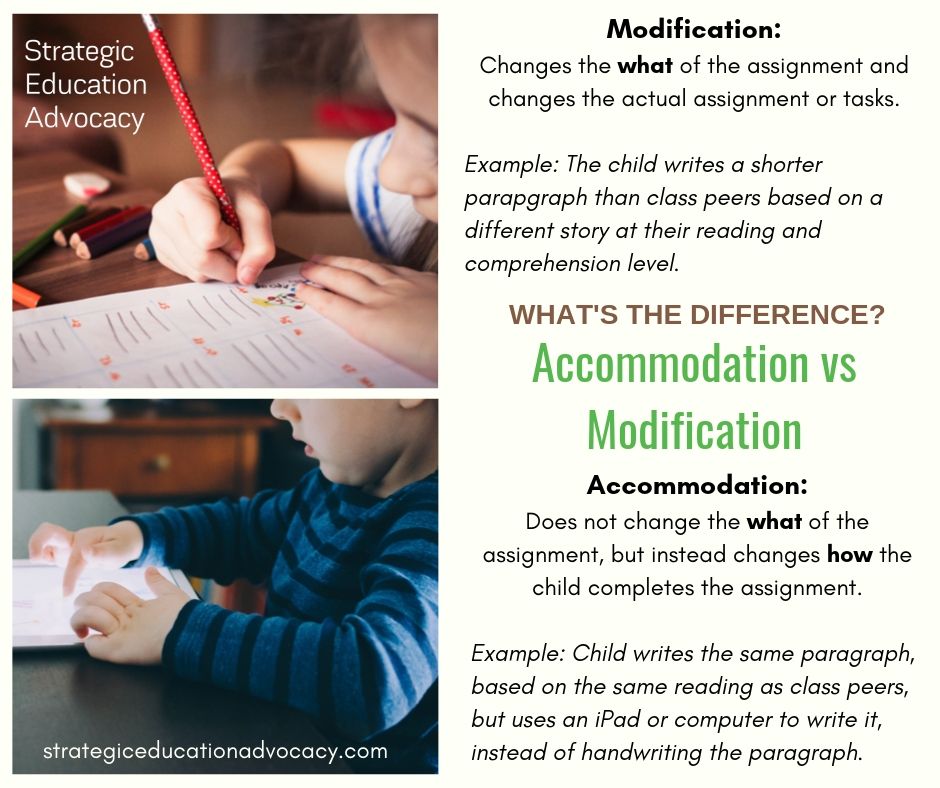
As advocates we often get questions from parents about the difference between an accommodation and a modification in their child’s IEP.
Let’s take a moment to explain:
Where are Accommodations and Modifications in the IEP?
In Special Education, accommodations and modifications are listed on the Offer of FAPE page of your child’s IEP in two separate sections. Here is the difference between them and why each is an important piece of your child’s IEP:
Accommodations
Accommodations are placed in an IEP to help the child demonstrate their knowledge and eventual mastery of a skill, but allow for the child to do so in a manner or using a tool that meets their unique need. The accommodation does not change what the child does in the assignment, but instead changes how they do it. Let’s use a math assignment as our example.
Joe and his class are working on a 10 question class assignment during math period focused on triple digit, multi-step multiplication problems. Joe is completing the same problems as the other students in class. He will learn the same steps to complete each problem, however Joe’s disability makes it difficult for him to rote memorize his math facts. Joe’s IEP has an accommodation that allows Joe to use a multiplication chart. In class his peers work through the steps of completing each of the 10 triple digit math questions without a multiplication chart and using their math facts memorization skills to complete each step of the problems. Joe brings his multiplication chart out and uses that chart to complete each step of all 10 questions. This is Joe’s accommodation. He is still learning the steps needed to complete a triple digit multiplication problem, he is still completing all 10 questions just as his class peers are doing, but with the use of his multiplication chart.
Modifications
Modifications are placed in an IEP to help the child demonstrate their knowledge and eventual mastery of a skill that is at their level, which may be different than the level of their class peers. Modifications become critical to support students with disabilities in accessing the general education setting. The modification changes the what of what the child does in the classroom and in homework assignments and provides work that is at that child’s skill level, while supporting them in building their skills at their own pace. The assignment and/or tasks are changed to meet this child’s unique learning needs. Let’s use our classroom math assignment as our example again.
Kayla’s in the same class as Joe, and the class is working on a 10 question class assignment during math period focused on triple digit, multi-step multiplication problems. However, Kayla is still mastering double digit addition and subtraction skills and she currently is working towards completing 5 questions in each math period. Kayla attends a general education classroom, and her work in math period is modified to meet her unique need. While her class peers complete the 10 question multiplication assignment, Kayla is completing a 5 question double digit addition and subtraction in-class assignment. Her math assignment is completely different from her class peers, and the assignment has been modified in skill and quantity to meet her unique need. This allows Kayla to access her same age peers and social needs as well as grade level curriculum in other areas of learning, while still meeting her unique needs in the area of math.
How are accommodations and modifications determined?
Each year at Joe and Kayla’s IEP meetings, the team will review these modifications and accommodations and determine if they are still needed. Part of the review process, is to determine if they are still appropriate. If you were Joe or Kayla’s parent you would be part of that process – remember, parents are always a critical and important team member of the IEP team.
When a student is struggling to access the content in class it is time to review the accommodations and modification in the student’s IEP. When you see your child struggling (grades, student struggling with homework, student complaining about class) call an IEP team meeting and call that meeting in writing to begin the clock ticking on the timeline for convening an IEP team meeting in your state.
When a student moves from elementary school to middle school, from middle school to high school or from one school to another school, always have a team meeting to review the relevancy of the student’s accommodations and modification.
When an accommodation or modification is suggested, be sure to have the document explain how it is implemented, when and where it is implemented and who is responsible for implementing it. For example:
If a student receives a grade lower than a C on a test the student may retake the test for a higher grade.
Questions to ask:
➡ Who initiates the retaking of a test? The teacher or student? If it is the student, do they have the self advocacy skills to do so?
➡ What happens between the original test and the retake to help support the student performing better on the test? Is there 1:1 review of material? A study guide? Tutoring?
➡Where and when does the student retake the test? In a study skills class? During lunch (let’s hope not! Lunch is important so make sure this is not the case). Is it a day later? A week later?
These are all important pieces to the accommodation you want included in the IEP document so that all parties understand how to implement the accommodation consistently.
Lastly, do not ever lose sight of the “I” in the IEP: YOUR STUDENT. All accommodations and modifications are unique to your child’s needs. It is not a drop down menu, this is about what your child needs to access their education and to succeed.
